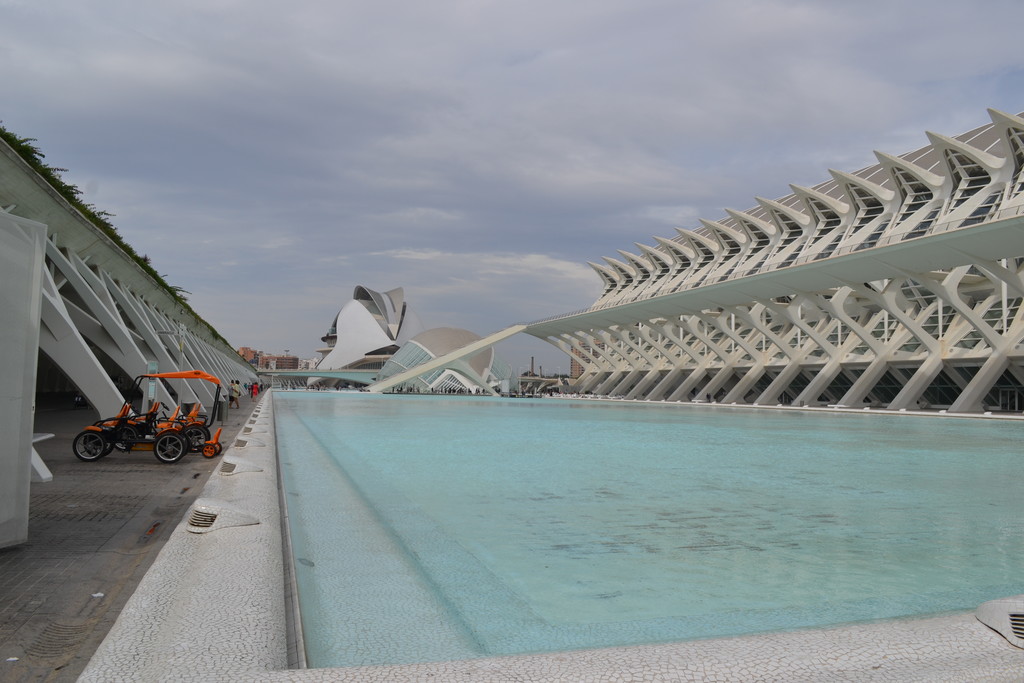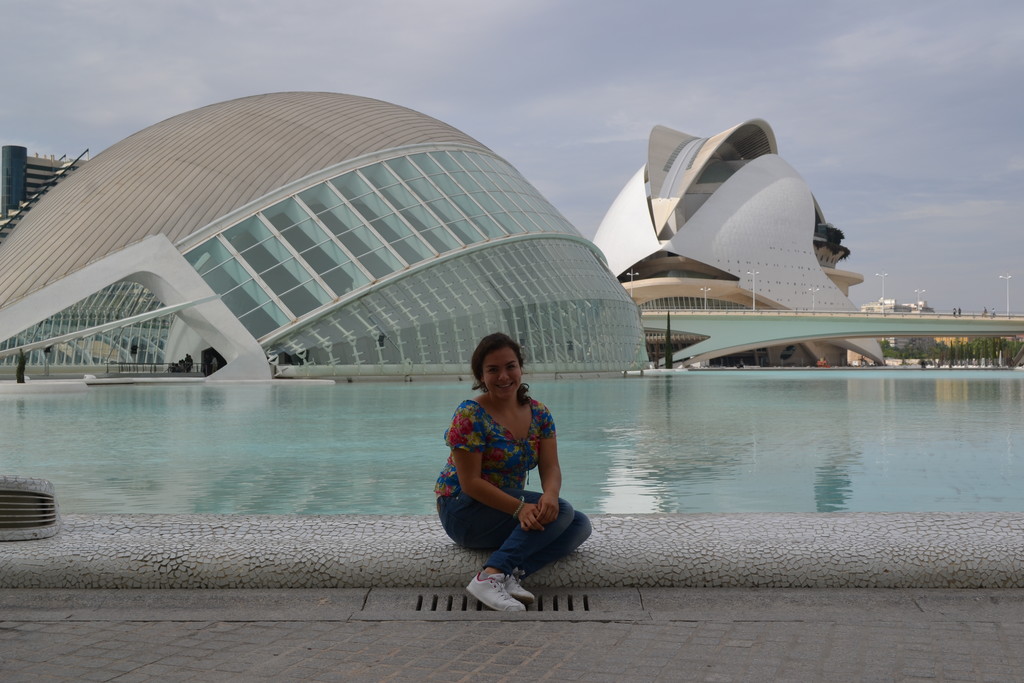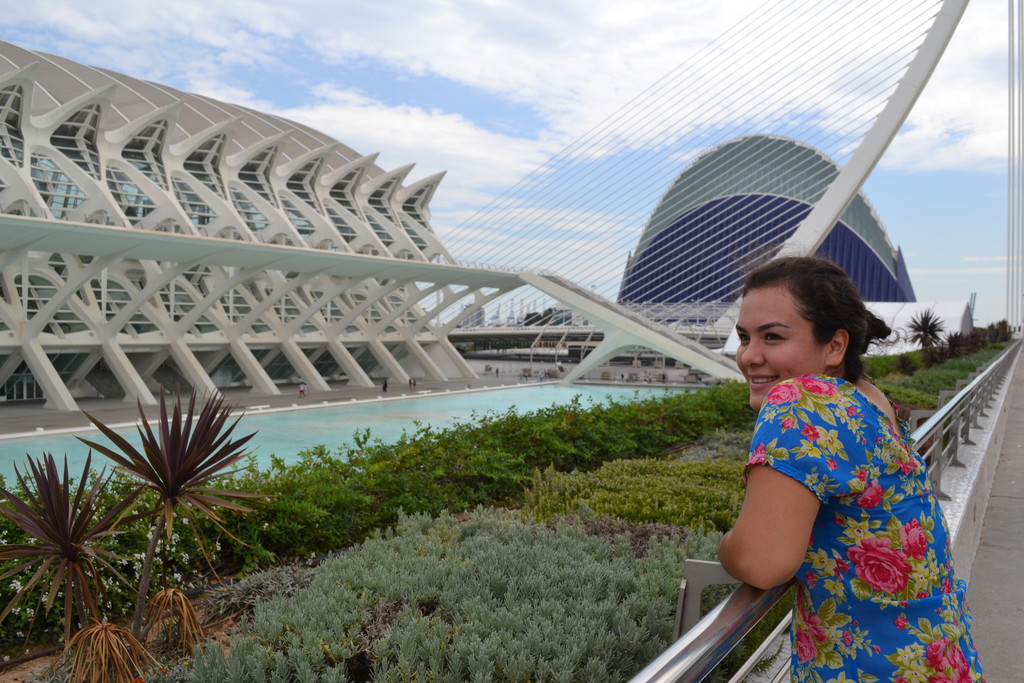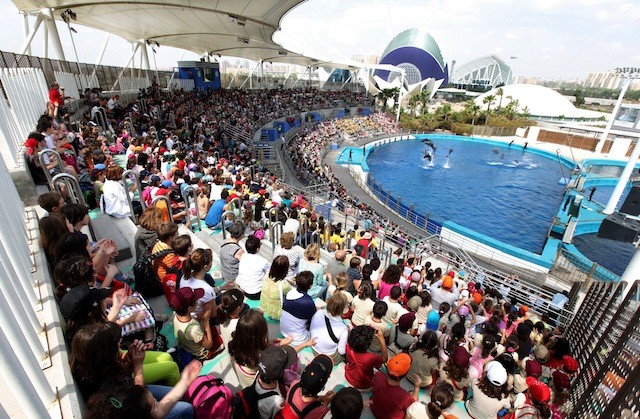One of the main attractions, and reasons why lots of people want to come to Valencia, is the impressive architectural complex of the City of Arts and Sciences, or Ciutat de les Arts i les Ciències, in Catalan.
It's important to mention that, although the official language in Spain is Castilian, or Spanish, in some regions, like the Valencian Community, they also speak Catalan. In fact, whilst out and about in the city, you will find road and street signs in Catalan with their translations on maps. The majority of Valencia's residents usually speak Spanish just as well as they do Catalan, so it's for this reason that you will find directions and signs in both languages in public places.
The vast size of the entire complex is something that is visually imposing the first time that you visit the City of Arts and Sciences; this modern art construction is one of the most important in the world and one of the main attractions in Valencia.

In this post, I want to tell you about my experience visiting the architectural complex of the City of Arts and Sciences, which you have to visit, even if it's just to admire its beautiful architecture. And, although I won't talk in detail about each of its four main attractions as I consider them to be too big to condense into a few paragraphs, I will give you my overall impressions, so you can visit without actually having to go to the attractions. Given that its architecture is so spectacular, it's worth going there even if it's just to admire it from the outside, meaning that you won't have to dedicate too much time to it.
A little bit of background about the complex
The complex leaves architects speechless, and the first thing that they want to know is who could have designed something so structurally-sound. The people responsible for such a beautiful design are the Spaniards, Santiago Calatrava and Félix Candela, who were supported by the engineers, Alberto Domingo and Carlos Lázaro.
The land where the architectural complex is situated was previously home to the Jardín del Turia. The Jardín del Turia is one of the urban complexes located where the course of the River Turia used to be, which was actually altered by the government as it posed a great danger to the city's inhabitants. These gardens are comprised of 120 hectares of land, so the remaining space was sufficient enough to develop a project that would give an emblematic addition to Valencia as a city. It was José María López who initially had the idea of building a science museum. I don't think that anyone would have imagined that, years later, something as big as the City of Arts and Sciences is today would have been created.
What is the City of Arts and Sciences complex made up of?
First, we will describe L'Oceanografic, a building where a beautiful aquarium is located, which, in fact, is the largest in Europe. Within the aquarium itself, there is an infinite number of marine species brought together from all types of aquatic ecosystems, and some have even been brought from the Red Sea or the Mediterranean. You definitely cannot miss one of the little aquariums, as well as its very own dolphinarium, which house more than 500 species of water-based animals, like: dolphins, walruses, sea lions, porcupine fish, tortoises, rays, sharks, penguins (yes, you read that correctly, they have penguins! ), and even some non-aquatic animals, like Valencian birds and those found in tropical evergreens.
The Museo de las Ciencias Príncipe Felipe is situated just in front of L'Oceanografic, and is centred around science and technology exhibitions. This museum was inaugurated 15 years ago, but this has not stopped it from gaining world recognition for its different floors with both temporary and permanent exhibitions, through which many cultural events are organised. One of its most important slogans reflects the importance of children getting involved and learning: "It's absolutely permitted to touch, to feel, to think". We have a similar museum in Mexico called Papelote Museo del Niño (there's a review that I wrote about it on my profile), and it really reminds me of it because it also has a similar slogan: "Touch, play, and learn". They are museums with a philosophy that really look to entertain children, encouraging learning in a fun way! And the good thing is that both adults and children alike can really enjoy themselves there.
L'Umbracle will be one of the first buildings that you'll find in the complex, and is a public urban garden; in fact, many cultural events and parties are often organised here. A friend of mine doing an exchange here in Valencia told me that their welcome party was held here. Within the garden itself, there is a lounge-type space that also has lots of palm trees, flowers, and plants that are really typical of the Valencian Community.

The next building, called L'Hemisferic, was visually my favourite. Like the Museo de las Ciencias del Príncipe Felipe, its main focus is science, and the building resembles the shape of an eye or a shell. Inside, the IMAX Dome cinema can be found, where newly-released films are shown; for example, when I went recently, they were screening the film, Del Revés. However, they also hold screenings of astronomical productions (like a planetarium), as well as screenings of some really interesting documentaries.

The final, but still equally as important, building is the Palau de les Arts Reina Sofia, which has four main rooms that hold operatic events. It's this very part of the complex that gives "of the Arts" to its name.

The final attraction built within the complex is the L'Àgora building, which is mainly used as a venue for the meeting of congresses, conventions or concerts, and has even been the site of important tennis tournaments. Like the other buildings, its architecture doesn't leave a lot to be desired, so it's just as much worth visiting this architectural structure too.
Like you can see in the photos, there is a huge decorative pool with very light-coloured water, and this is used for those who want to enjoy the experience of renting a water ball and walk on water. And, if you fancy more of a family-oriented activity, you can rent a kayak and have a fun-filled and refreshing day, especially during the summer.
How much does it cost to visit?
If you want to save some money, I recommend buying your tickets online through the aforementioned website, as they give you a 10% discount.
There are lots of ticket combinations, but I'll just explain the most important ones:
Entry fees to the attractions are as follows: L'Hemisferic costs 8. 80€; the Museo de las Ciencias del Príncipe Felipe, 8€; and, L'Oceanografic, at the highest price of 27. 90€. If you paid for each ticket separately, it would cost you 43. 90€, however, if you buy the ticket package that includes all three, the cost would only be 36. 25€ (a saving of more than 7€) and it gives you a period of up to three days to visit. If you are one of the lucky ones who lives in Valencia, I recommend that you buy the annual pass, which, for just 50€, allows you to visit an unlimited number of times during the entire year (from the date of purchase).
If you come with your ISIC international student card or young person card, it won't ensure that you get free entry, but I still recommend bringing it with you and showing it at the ticket office, as, in some places in the city, they give you sizeable discounts. For example, in the ticket package, the one that includes entry to the three attractions, that I mentioned earlier, they give you a 6€ discount off the regular ticket price, meaning that it will only cost you 30€ to see everything.
If you aren't interested in seeing all three of the attractions that I have mentioned, but you do want to see more than one, you can choose some ticket combinations for two attractions on the website.
How long will it take me to see each building?
The ticket packages can be used for up to 3 days, as there is a lot to see and enjoy, and it's interesting seeing each of the buildings in minute detail. You could get away with spending less time at L'Hemisferic, as the presentation of its projects generally only takes 50 minutes. However, in the case of the Museo de las Ciencias del Príncipe Felipe, the average visit time is 3 hours, and for L'Oceanografic, up to 4 hours.
What are the opening hours?
The complex opens 365 days a year! Its opening hours usually vary depending on the time of year, although they are generally from 10am to 7pm, closing at 6pm in the off-peak season and 9pm in peak season.
How do I get there?
I remember that the first time I went, I made the decision to walk there, given its close proximity to the city centre. So, if you decide to walk, I recommend that you go through the Jardín del Turia in the opposite direction to Bioparc. The second time I visited, things worked out much better, as my friend gave me a tour by bike. I was amazed when we toured the city using the "Valenbisi" system, that is dotted around different areas throughout the city, designed for bicycle renting; it's a very easy, safe, fun, and environmentally-friendly to get to any place in and around Valencia.
If you go by bike, it'll be the best decision, as the route passes through the Jardín del Turia, specifically the way you'll know already, and you only have to follow the path of the old riverbed. When you see an incredible construction, one that is both enormous and imposing, you will know that you have arrived.
I don't recommend travelling there by metro, as the closest stop is Alameda, which is located a 15 minute walk away from the complex.
If you want to go by bus, you can take any of the following services: 1, 13, 14, 15, 19, 35, 40 and 95.
Recommendations
- It works out much cheaper buying the combination ticket that allows you access to L'Hemisferic, L'Umbracle and L'Oceanografic; it's really worthwhile buying this in advance on their website.
- Buy your tickets in advance, as tickets for some attractions sell out for certain dates and at weekends, especially tickets for L'Hemisferic.
- If you don't live in Valencia and you still want to go, don't worry at all, as there are usually ticket packages that include return train tickets with Renfe.
- You have to see the City of Arts and Sciences at night, as you'll have a fantastic illuminated view of the complex. You won't at all regret it because the night-time lighting is stunning.
- Outside, you will find many stalls where they sell horchata; we also have this water in my country, but it's made completely differently here. The horchata that they sell here is water-free and made with tiger nuts. If you've never tried it, I'd recommend doing so because it's delicious.
- You cannot bring food into the complex.
- The complex has an on-site cloakroom, which costs 2 euros per item, so it would be preferable to bring as few things possible with you, given that you have to walk a lot too.
- Visit the museum in the off-peak season, in the months between November and March.
 What to see Valencia,
Valencia,
Spain
What to see Valencia,
Valencia,
Spain


























